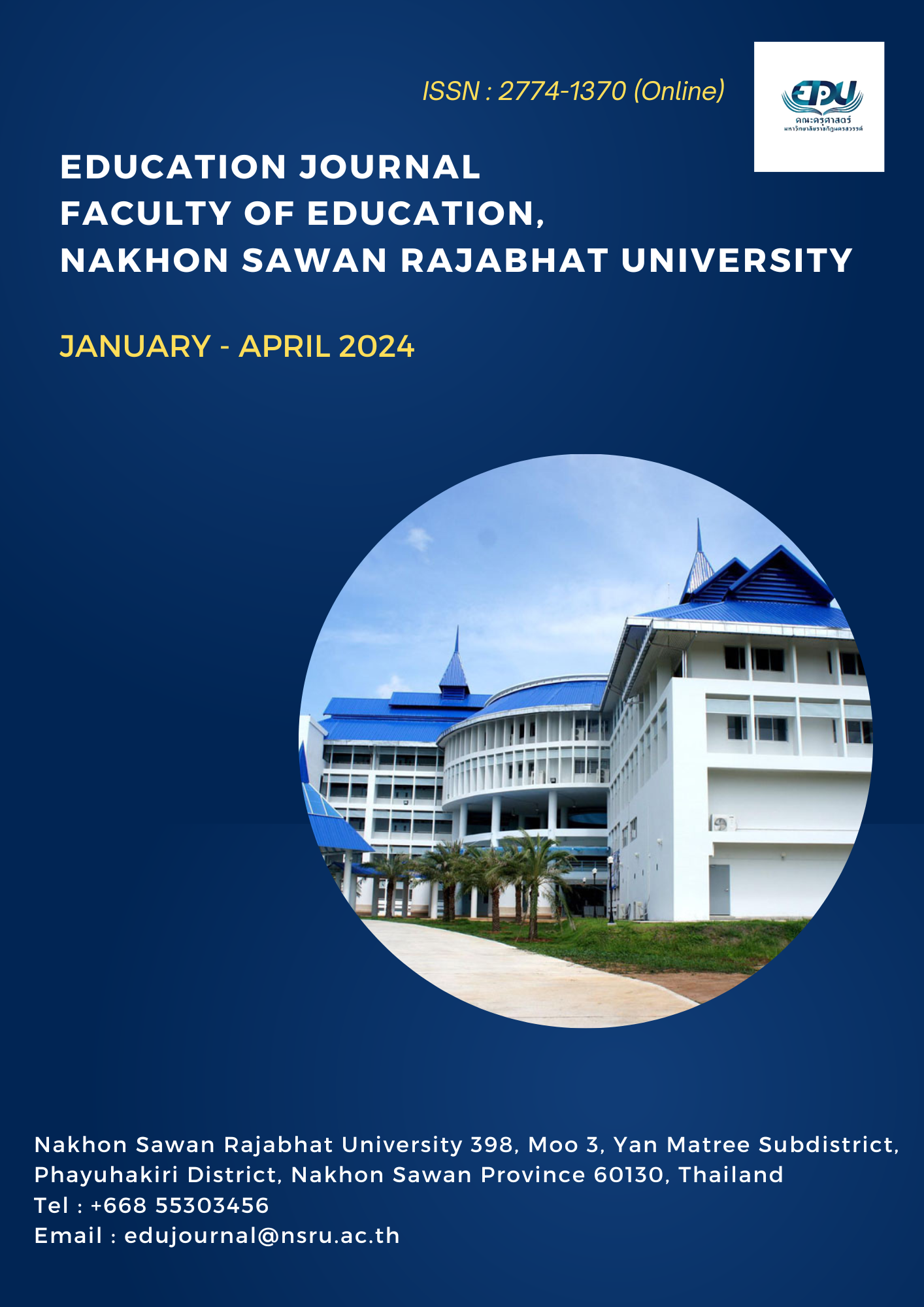Development of The 2W3P Learning Activity Package with Phonics Foreign Language Department Secondary School Level 2 Thasaeratchadapisake School Chumphon Province
Main Article Content
Abstract
The objective of this research was: 1) to develop the 2W3P learning activity package with phonics foreign language department (E1/E2) and the effectiveness index (E.I.) according to the criteria of 75/75 and 0.50 or more, 2) to compare academic achievement between pretest and posttest, 3) to compare the English vocabulary pronunciation skills of students between pretest and posttest, and 4) to study the satisfaction of students after using the English learning activity package. It was the one group experimental research with pretest and posttest design. The sample was the 2nd year high school student of Thasaeratchadapisake School, the 1st semester of the academic year 2022, amount 40 people. The tools used in the research were: a set of 7 English learning activities with accuracy and suitability with averages of 4.07-4.23, 7 lesson plans with accuracy and suitability with averages of 4.20-4.40: an achievement test, 30 items, with difficulty values of 0.58-0.80, discrimination power values of 0.28-0.67, and a reliability value of 0.93 and a questionnaire of student satisfaction toward learning activity package, 20 items, with discriminant power of 0.84-0.97 and a reliability value of 0.99. Data were analyzed using basic statistics, including percentage and t-test. The results showed that:
1) the English learning activity set had an efficiency of 85.43/90.50, higher than the specified criteria, and the effectiveness index value of 0.79, which meets the specified criteria, 2) the students had an average of 27.15 points posttest was higher than an average of 16.40 points pretest, with a statistical significance at the .05 level. 3) the students had an average English vocabulary pronunciation of 26.30 points posttest was higher than an average of 14.85 points pretest, with a statistical significance at the .05 level, and 4) the student's satisfaction toward learning with the English learning activity package was an average of 4.34 at the high level.
Downloads
Article Details

This work is licensed under a Creative Commons Attribution-NonCommercial-NoDerivatives 4.0 International License.
References
กระทรวงศึกษาธิการ. (2551). การจัดสาระการเรียนรู้ กลุ่มสาระการเรียนรู้ภาษาต่างประเทศตามหลักสูตรแกนกลางการศึกษาขั้นพื้นฐาน พุทธศักราช 2551. กรุงเทพฯ: โรงพิมพ์คุรุสภาลาดพร้าว.
ก็ก่อ พิสุทธิ์, และกัลยรัตน์ ชาวันดี. (2561). การพัฒนาทักษะการออกเสียงภาษาอังกฤษ โดยใช้ชุดฝึกทักษะโฟนิกส์ออนไลน์ของนักเรียนชั้นมัธยมศึกษาปีที่ 6 โรงเรียนเต่างอยพัฒนศึกษา. สกลนคร: โรงเรียนเต่างอยพัฒนศึกษา.
จักรพงษ์ สายทองติ่ง. (2562). พัฒนาการของการอ่านออกเสียงภาษาอังกฤษของนักเรียนชั้นมัธยมศึกษาปีที่ 4 โรงเรียนไตรมิตรวิทยาลัยโดยใช้แบบฝึกทักษะการอ่านออกเสียงภาษาอังกฤษ. ปราจีนบุรี: ศูนย์แห่งความเป็นเลิศด้านการสอน เครือข่ายวิจัยโรงเรียนสายปัญญา.
ชุมศักดิ์ มัธยมจันทร์. (2557). วิธีออกเสียงและสำเนียงภาษาอังกฤษ. กรุงเทพฯ: โรงพิมพ์วิฑูรย์การปก.
ชัยยงค์ พรหมวงศ์. (2556). การทดสอบประสิทธิภาพสื่อหรือชุดการสอน. วารสารศิลปากรศึกษาศาสตร์. 5(3): 7-20.
ซารีป๊ะ รักดี. (2559). การพัฒนาการจัดการเรียนรู้ภาษาอังกฤษแบบ 2W3P โดยใช้หนังสืออ่านเพิ่มเติม ชุด A little Guide เพื่อส่งเสริมทักษะการอ่านและผลสัมฤทธิ์ทางการเรียน กลุ่มสาระการเรียนรู้ภาษาต่างประเทศ ระดับชั้นประถมศึกษาปีที่ 6. วารสารเทคโนโลยีและสื่อสารการศึกษา (ศึกษาศาสตร์). 2(5): 42-48.
ณัฐพร สุขเกษม, นิธิดา อดิภัทรนันท์, และจารุณี มณีกุล. (2558). การใช้การสอดแทรกโฟนิกส์ร่วมกับการใช้สื่อสภาพจริง เพื่อส่งเสริมการอ่านออกเสียง ความรู้คำศัพท์ และความสามารถในการอ่านภาษาอังกฤษของนักเรียนระดับชั้นมัธยมศึกษาปีที่ 4. วิทยานิพนธ์ปริญญามหาบัณฑิต (การสอนภาษาอังกฤษ). มหาวิทยาลัยเชียงใหม่.
เทียนมณี บุญจุน. (2558). สัทศาสตร์ ระบบเสียงในภาษาอังกฤษและภาษาไทย. กรุงเทพฯ: โอเดียนสโตร์.
ปารมี เชยวัดเกาะ, และอโณทัย พลเยี่ยม เพชรแสง. (2562). การพัฒนาทักษะการอ่านคําศัพทภาษาอังกฤษโดยการสอนแบบโฟนิกส์สำหรับนักเรียนชั้นมัธยมศึกษาปที่ 2. วารสารมนุษยศาสตร์และสังคมศาสตร์ วไลยอลงกรณ์ ในพระบรมราชูปถัมภ์. 16(1): 72 - 81.
พิณทิพย์ ทวยเจริญ. (2563). การพูดภาษาอังกฤษตามหลักภาษาศาสตร์. (พิมพ์ครั้งที่ 3). กรุงเทพฯ: สำนักพิมพ์มหาวิทยาลัยธรรมศาสตร์.
พิสุทธา อารีราษฎร์. (2560). การพัฒนาซอฟท์แวร์ทางการศึกษา. มหาสารคาม: อภิชาตการพิมพ์.
รุ่งอรุณ โรจน์รัตนาดำรง ไชยศรี. (2560). วิธีการสอนแบบโฟนิกส์. สารานุกรมศึกษาศาสตร์. (ฉบับที่ 52): 54.
ศิริลักษณ์ สกุลวิทย์. (2561). แบบฝึกการออกเสียงและเขียนคำเป็นภาษาที่สอง. เชียงใหม่: สำนักพิมพ์มหาวิทยาลัยเชียงใหม่.
สำนักงานเลขาธิการสภาการศึกษา. (2557). รายงานการวิจัยแนวทางการพัฒนาการศึกษาไทยกับการเตรียมความพรอมศตวรรษที่ 21. กรุงเทพฯ: สำนักงานเลขาธิการสภาการศึกษา.
สุมิตรา อังวัฒนกุล. (2561). วิธีสอนภาษาอังกฤษ. (พิมพครั้งที่ 4). กรุงเทพฯ: สำนักพิมพจุฬาลงกรณมหาวิทยาลัย.
อัจฉรา วงศ์โสธร. (2557). การทดสอบและประเมินผลการเรียนการสอนภาษาอังกฤษ. กรุงเทพฯ: สำนักพิมพ์จุฬาลงกรณ์มหาวิทยาลัย.
Anderson, H. I., & Dearborn, Water. (1952). The Psychology of Teaching Reading. New York: The Ronald Press. Retrieved June 8, 2023, from http://ejournals.swu.ac.th/index.php/jre/article/viewFile/ 10404/8705/.
Brown, H. (1994). Teaching by principles. USA: Prentice Hall Regents.
Finocchiaro, M., & Brumfit, C. (2016). The functional-Notional Approach: From Theory to Practice. New York: Oxford University Press.
Florida Department of Education. (2019). FCAT 2.0 Test Item Specifications. Retrieved January 20, 2022, from http://www.fldoe.org/accountability/assessments/k-12-student-assessment/archive/fcat-2-0/test-items-specifications.stml.
Grant, R. M. (2016). The resource-based theory of competitive advantage: implication for strategy Formula. California Management Review. 33(3): 114.
Lewis, B. (2016). General Education: Exploration. (2nded.). Washington, D.C: American Council on Education.
National Institute of Literacy. (2019). Put Reading First. USA: the Center for the Improvement of Early Reading Achievement (CIERA), 41.
Zimmerman, B. J. (2017). A Social Cognitive View of Self-Regulated Academic Learning. Journal of Educational Psychology. 81(3): 329 - 339.


